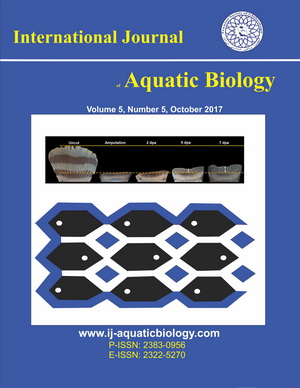Pathogenic Vibrios associated with loose shell syndrome in mangrove crabs (Scylla spp.)
Downloads
An emerging disease known as loose shell syndrome, with unknown etiology, impacts mangrove crab aquaculture in the Philippines. This study investigated the presence and characterized pathogenic Vibrio spp., which might be implicated in loose shell syndrome in mangrove crabs, Scylla spp. Five bacterial isolates associated with loose shell syndrome in mangrove crabs were obtained and purified. Polymerase chain reaction (PCR) amplification using Vibrio-specific primers identified one isolate carrying the hemolysin (vhh) virulence gene of Vibrio harveyi, which was later confirmed by sequencing of the 16S rRNA. The other non-Vibrio isolates were Proteus, Shewanella, and Stutzerimonas. This study provides valuable insights into the possible etiology of loose shell syndrome in mangrove crabs, contributing to a better understanding of whether the condition stems from bacterial, environmental, or a combination of both factors.
Downloads
AftabUddin S., Roman W.U., Hasan C.K., Ahmed M., Rahman H., Siddique M.A.M. (2018). First incidence of loose-shell syndrome disease in the giant tiger shrimp Penaeus monodon from the brackish water ponds in Bangladesh. Journal of Applied Animal Research, 46(1): 210-217.
Caipang C.M.A., Brinchmann M.F., Kiron V. (2010) Antagonistic activity of bacterial isolates from intestinal microbiota of Atlantic cod, Gadus morhua, and an investigation of their immunomodulatory capabilities. Aquaculture Research, 41: 249-256.
Capella-Gutierrez S., Silla-Martinez J.M., Gabaldon T. (2009). trimAl: a tool for automated alignment trimming in large-scale phylogenetic analyses. Bioinformatics, 25: 1972-1973.
Castroverde C.D.M., San Luis B.B., Monsalud R.G., Hedreyda C.T. (2006). Differential detection of vibrios pathogenic to shrimp by multiplex PCR. Journal of General and Applied Microbiology, 52(5): 273-280.
Clinical and Laboratory Standards Institute (CLSI). (2015). Methods for antimicrobial dilution and disk susceptibility testing of infrequently isolated or fastidious bacteria. 3rd ed. CLSI guideline M45. Wayne, PA. 120 p.
Haseeb M., Singh I.S. (2012). Development of zero water exchange shrimp culture system integrated with bioremediation of detritus and ammonia nitrogen [Dissertation]. National Centre for Aquatic Animal Health Cochin University of Science and Technology; Kochi, Kerala, India.
Holt G.J., Krieg N.R., Sneath P.H.A., Staley J.T., Williams S.T. (2000). Bergey’s manual of determinative bacteriology. Ninth edition. Lippincott Williams and Wilkins, Philadelphia, USA. 787 p.
Jayasree L., Janakiram P., Madhavi R. (2006). Characterization of Vibrio spp. associated with diseased shrimp from culture ponds of Andhra Pradesh (India). Journal of the World Aquaculture Society, 37(4): 523-532.
Jayasree L., Janakiram P., Madhavi R. (2008). Isolation and characterization of bacteria associated with cultured Penaeus monodon affected by loose shell syndrome. Journal of Aquaculture - Bamidgeh, 60: 46-56.
Katoh K., Rozewicki J., Yamada K.D. (2019). MAFFT online service: multiple sequence alignment, interactive sequence choice and visualization. Briefings in Bioinformatics, 20: 1160-1166.
Kongrueng J., Yingkajorn M., Bunpa S., Sermwittayawong N., Singkhamanan K., Vuddhakul V. (2015). Characterization of Vibrio parahaemolyticus causing acute hepatopancreatic necrosis disease in southern Thailand. Journal of Fish Diseases, 38(11): 957-966.
Letchumanan V., Pusparajah P., Tan L.T-H., Yin W-F., Lee L-H., Chan K-G. (2015). Occurrence and Antibiotic Resistance of Vibrio parahaemolyticus from Shellfish in Selangor, Malaysia. Frontiers in Microbiology, 6: 735.
Lin P., Wei C.L. (2012). Genomic DNA QC using standard gel electrophoresis (for collaborators). Doe Joint Genome Institute: Berkeley, CA, USA. pp: 1-11.
Naik M.K., Reddy M.H., Reddy M.S. (2020). Occurrence of loose shell syndrome disease in culture operation of shrimp Litopenaeus vannamei in different regions of Andhra Pradesh. International Journal of Fisheries and Aquatic Studies, 8(4): 274-279.
Paydar M. (2013). Isolation and differentiation of Vibrio species from seafood and molecular characterisation of Vibrio parahaemolyticus [dissertation]. University of Malaya (Malaysia).
Rahman M.S. (2020). Diversity of Vibrio Species’ and their antibiotic resistance patterns in black tiger shrimp Penaeus monodon Fabricius, 1798 cultured in South-West region of Bangladesh. Asian Fisheries Science, 33(4).
Rañoa D.R.E., Hedreyda C.T. (2005). Sequence analysis of partial toxR gene from Philippine Vibrio isolates and design of toxR-targeted primers for detection. Journal of General and Applied Microbiology, 51(6): 343-351.
Saha S., Pradhan D., Dash G. (2023). Studies on diversity of bacterial diseases and occupational risks through mudcrab aquaculture in West Bengal. Journal of Pure and Applied Microbiology, 17(2): 722-731.
Shikongo-Nambabi M. (2012). Identification of Putative Vibrio Species Isolated from Processed Marine Fish Using Thiosulphate-Citrate-Bile-Sucrose (TCBS) Agar. BBJ, 2(4): 229-246.
Soto-Rodriguez S.A., Lozano-Olvera R., Ramos-Clamont Montfort G., Zenteno E., Sánchez-Salgado J.L., Vibanco-Pérez N., Aguilar Rendón .KG. (2022). New Insights into the Mechanism of Action of PirAB from Vibrio parahaemolyticus. Toxins, 14(4): 243.
Triño A., Rodriguez E., Coniza E., Juanga B. (1999). Mudcrab. Tigbauan, Iloilo, Philippines: Aquaculture Dept., Southeast Asian Fisheries Development Center.
Uddin S., Nurul M., Rahman M., Zafar M. (2013). Antibiotic resistance of Vibrio bacteria isolated from mud crab Scylla serrata of Chakoria Coast, Bangladesh. Research Journal of Pharmaceutical, Biological and Chemical Sciences, 4(3): 325.
Venkateswaran K. (1999). VIBRIO | Standard Cultural Methods and Molecular Detection Techniques in Foods. In: Encyclopedia of Food Microbiology. Elsevier. pp: 2248-2258.
Weil A.A., LaRocque R.C. (2020). Cholera and other vibrios. In: Hunter's Tropical Medicine and Emerging Infectious Diseases. Elsevier. pp. 486-491.
Yudiati E., Subagiyo, Azhar N. (2021). Antimicrobial susceptibility and minimum inhibition concentration of Vibrio parahaemolyticus, Vibrio vulnificus and Vibrio harveyi isolated from a white shrimp (Litopenaeus vannamei) pond. IOP Conference Series: Earth and Environmental Science, 763(1): 012025.
Copyright (c) 2025 International Journal of Aquatic Biology

This work is licensed under a Creative Commons Attribution 4.0 International License.








